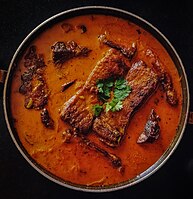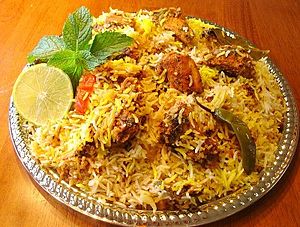Bengali cuisine/ja: Difference between revisions
Created page with "''ションデシュ''、''チャナール・ジラピ''、''カロ・ジャム''、''ラゴブシャイ''、''パントゥア''、''ジョルボラ・ションデシュ''、''ロシュボラ''、''ロード・チョムチョム''、''パエシュ''、''ブンディヤ''、''ナレングル・ションデシュ''、''マルポア''、''ショル・バジャ''、''ラングチャ''、''ババルサ''、その他様々なものがベンガル..." |
|||
| (24 intermediate revisions by the same user not shown) | |||
| Line 81: | Line 81: | ||
[[:en:Chinese of Kolkata|コルカタの中国人]]は、もともと18世紀後半に[[:en:Kolkata|コルカタ]]の南にある[[:en:Achipur|アチプール]]という村に定住し、その後市内へ移り、最終的にコルカタ東端の[[:en:Tangra, Calcutta|タングラ]]にある現在の場所に移った。コルカタの中国系の人々は、明確なアイデンティティを持つ実質的で成功したコミュニティを形成している。このアイデンティティとともに、中華料理がもたらされ、現在コルカタのほぼすべての街角で入手可能である。これは、その味、素早い調理法、そして醤油の使用以外は元の中国のレシピとは似ていないことによる。彼らは主に[[:en:Cantonese people|広東人]]の商人や船員であり、最初にここに定住し、手元にあるもので料理することにしたのである。 | [[:en:Chinese of Kolkata|コルカタの中国人]]は、もともと18世紀後半に[[:en:Kolkata|コルカタ]]の南にある[[:en:Achipur|アチプール]]という村に定住し、その後市内へ移り、最終的にコルカタ東端の[[:en:Tangra, Calcutta|タングラ]]にある現在の場所に移った。コルカタの中国系の人々は、明確なアイデンティティを持つ実質的で成功したコミュニティを形成している。このアイデンティティとともに、中華料理がもたらされ、現在コルカタのほぼすべての街角で入手可能である。これは、その味、素早い調理法、そして醤油の使用以外は元の中国のレシピとは似ていないことによる。彼らは主に[[:en:Cantonese people|広東人]]の商人や船員であり、最初にここに定住し、手元にあるもので料理することにしたのである。 | ||
コルカタから他国への移民もこれを海外に持ち出すようになっている。インド中華料理店はアメリカとイギリスの多くの場所に出現している。 | |||
インド中華料理は、1950年代に[[:en:14th Dalai Lama|第14世ダライ・ラマ]]の亡命を受けて多数のチベット人がインド領内に移住して以来、再び人気が高まっている。チベット人は、人気の[[Momo (food)/ja|モモ]](餃子の一種)や[[thukpa/ja|トゥクパ]](ボリュームのある麺スープ)など、独自の味の好みをこのジャンルに加えた。チベット人やネパール人移民は、現在コルカタのほぼすべての通りで見られる多くの台所で簡単に職を見つけたのである。 | |||
====アッダ==== | |||
=== | {{Main/ja|Adda (South Asian)/ja}} | ||
{{Main|Adda (South Asian)}} | アッダ({{langx|bn|আড্ডা}})は、仕事中に食事をしながら交流するベンガル地方の伝統的な習慣である。アッダ中に食べるものは、通常、ミシュティや[[Confectionery/ja|菓子]]、紅茶、コーヒーだが、揚げ魚のようなボリュームのある肉料理が出されることもある。 | ||
アッダは植民地時代に[[:en:Bhadralok|バドラロク]]の[[:en:Guild|ギルドメンバー]]の間で盛んになり、様々な話題について話し合う場であった。 | |||
<blockquote>「ある瞬間にチャールズとカミラの結婚について話していたかと思うと、次の瞬間にはインドとパキスタンの最新クリケットシリーズに話が移り、また[[:en:Rabindranath Tagore|タゴール]]をめぐる最近の論争に戻ることもできた。」</blockquote> | |||
職人の趣味であったため、女性はアッダからほとんど隔離されていたが、アッダの民主化と女性が社会生活でより大きな役割を占めるようになるにつれて、この感情は薄れ始めている。このため、アッダは「…家からの避難場所、職場の単調さや家庭生活から離れた中立的な待ち合わせ場所」と見なされていた。 | |||
植民地後、アッダは仕事のより厳格な構造や不必要な怠惰という搾取的な認識のために衰退している。このことは、「lyadh」(リラックスして充電するために何もしないこと)という概念に不可欠であると信じるベンガル人のかなりの動きを刺激している。しかし、アッダは依然として存在しており、休暇中や仕事後にクラブやコーヒーショップで参加されている。この伝統には、ギリシャの[[:en:symposium|シュンポシオン]]に相当するものさえあり、学生が食事をしながら勉強会をしたり、教師がよりリラックスした環境で教えたりすることもある。 | |||
===シレット=== | |||
[[Sylhet/ja|シレット]]は、有名な[[pilaf/ja|ピラフ]]料理である[[Akhni/ja|アクニ・ポラオ]]の一種を誇る。これは、米を後から炊き、鶏肉を切り分けて調理するものである。一般的に食べられる肉の種類には、[[Hash O Bash/ja|ハッシュ・オ・バッシュ]]のような料理で牛肉、[[Chicken as food/ja|鶏肉]]、[[Lamb and mutton/ja|マトン]]、アヒル/ガチョウなどがある。また、ベンガル地方の他の地域では見られない野生の柑橘系の果物を使ったご飯料理、[[Beef Hatkora/ja|ビーフ・ハトコラ]]の伝統を誇りにしている。 | |||
[[Sylhet]] | |||
イギリス統治時代、ビスケットと[[loaf/ja|パン]]がシレットに導入され、イスラム教徒コミュニティで人気を博した。しかし、[[:en:Cachar|カチャール]]とシレットの[[:en:Hindu|ヒンドゥー教徒]]の中流階級は、ビスケットやパンがイスラム教徒によって焼かれたと信じていたため、非常に疑念を抱いていた。ある時、カチャールの数人のヒンドゥー教徒が、イギリス人が紅茶と一緒にビスケットを食べているのを見かけ、騒動が起こった。この情報はシレットのヒンドゥー教徒に伝わり、小さな反乱が起こった。これに対応して、企業はパンを「機械製」で「(イスラム教徒の)手で触れていない」と宣伝し、ヒンドゥー教徒にパンが「安全に食べられる」ことを伝えようとした。この出来事は[[:en:Bipin Chandra Pal|ビピン・チャンドラ・パル]]の自伝に記されており、彼はいかにしてヒンドゥー教徒の食習慣が徐々に変化していったかを述べている。 | |||
==調理器具{{Anchor|Utensils}}== | |||
== Utensils == | [[File:Bengali kitchen utensils.JPG|thumb|left|284px|ベンガルの家庭で使われる様々な調理器具。]] | ||
[[File:Bengali kitchen utensils.JPG|thumb|left|284px| | ベンガル料理はしばしば、青やピンクの特徴的な花の模様が施された皿に盛り付けられる。ベンガル料理のもう一つの特徴は、boti(''dao''または''da''とも呼ばれる)の使用である。これは、片足または両足で押さえられた台の上に長い湾曲した刃が付いており、両手で切るものを持ち、使用者に向いた刃に当てて動かす。この方法は切断作業を効果的に制御し、エビから大きなカボチャまで何でも切ることができる。 | ||
[[Wok/ja|コライ]]は、ほとんどのベンガルソースや炒め物に使われる調理器具である。dekchi(平底の鍋)は、通常、大量の調理やご飯を炊くのに使われる。薄くて平らな蓋が付いており、ご飯を炊き終える際に澱粉をこし出すのにも使われる。tawaは[[roti/ja|ロティ]]や[[paratha/ja|パラタ]]を作るのに使われる。もう一つの主要な調理器具はhariで、これは丸底の鍋のような容器である。これら3つの容器はすべて、様々なサイズ、様々な金属や合金で提供されている。 | |||
khuntiと呼ばれる平らな金属製のへらは、hata(長い柄付きの柄杓)、jhanjri(揚げ物用の丸いざる状のへら)、shanrashi(火から器を取り除くためのやっとこ)、ghuntni(ダルをピューレにするための木製ハンドブレンダー)、木製のbelun chaki(丸い練り粉板と麺棒)、そして乳鉢と乳棒または研磨石の粗い形であるshil noraと共に頻繁に使用される。kuruniはココナッツをすりおろすためだけに使われる。 | |||
伝統的なベンガル料理では、銀食器は使われない。 | |||
===歴史=== | |||
[[File:Betel-leaf and Areca-nut.jpg|thumb|right|食後に提供されるのが一般的な「[[Paan/ja|パーン]]」と「[[areca nut/ja|スパリ]]」]] | |||
[[File:Betel-leaf and Areca-nut.jpg|thumb|right| | ベンガル人は通常、dastarkhanと呼ばれる布を敷いた床に座って食事をし、歴史的には銀食器を使わず、大きなバナナの葉やプランテンの葉を皿として、あるいは乾燥させた[[Sal tree/ja|サル]]の葉を縫い合わせた皿を使っていた。 | ||
客には訪問時間に応じた飲食物を提供するのが慣習である。食事の際には、家主の家族のごく高齢者やごく幼い者を除いて、客が最初に給仕される。家族内では、最も年長の男性(社会的地位が最も高い者または最年長者)から給仕が始まる。学齢期の子供たちは妻、義理の娘、そして最後に食事をする料理人の前に給仕される。 | |||
===現代=== | |||
=== | 植民地化以前は、食事の順序への遵守は社会的身分の指標であったが、イギリスやポルトガルの影響、そして中流階級の成長と共に、これは徐々に姿を消した。コースは頻繁に省略されたり、日常の食事と組み合わせられたりする。食事はかつて、最も若い主婦が客に一品ずつ給仕していたが、核家族化と都市化の影響により、これが置き換わった。現在では、すべての料理を食卓の中央に置かれた大皿に並べ、各自が取り分けるのが一般的である。結婚式のような儀式的な機会では、かつては凝った給仕の儀式があったが、今ではプロのケータリングやビュッフェ形式の食事が一般的になっている。しかし、大家族の行事やより豪華な儀式的な祝宴では、これらの規則が依然として守られる場合もある。 | ||
==食事{{Anchor|Meals}}== | |||
==Meals== | 毎日の食事は通常シンプルで、栄養バランスが考慮され、野菜が extensively に使われる。コースは一般的に軽いものから豊かで重いものへと進み、様々な味や味覚のリフレッシュを挟む。ご飯は食事全体を通して共通であり、chaţni([[chutney/ja|チャツネ]])のコースまでが食事の主要な構成要素となる。 | ||
===メインコース=== | |||
====魚==== | |||
==== | 魚はベンガル人の食生活の中心であり、主要なタンパク源である。ベンガル人は通常、淡水魚や汽水魚を料理に使う。魚の調理にはスパイスが多用され、魚は通常、カレーとして、または揚げたステーキとして提供される。人気の魚カレーには、''[[Wallago attu/ja|ボアル]]''、''[[rohu/ja|ローフ]]''、''[[ilish/ja|イリシュ]]''、''[[ompok/ja|パブダ]]''などがある。 | ||
一つの伝統として、チダルフィッシュの左側を油で調理するというものがある。 | |||
[[File:A_photo_of_popular_Bengali_dish_Sorshe_Ilish_served_traditionally.jpg|thumb|right|[[Shorshe Ilish/ja|ショルシェ・イリシュ]]]] | |||
[[File:A_photo_of_popular_Bengali_dish_Sorshe_Ilish_served_traditionally.jpg|thumb|right|[[Shorshe Ilish]]]] | |||
====甘味==== | |||
=== | ベンガル地方の甘味には長い歴史がある。17世紀にこの地域を旅したポルトガル人修道士[[:en:Sebastien Manrique|セバスチャン・マンリケ]]は、伝統的な方法で調理された乳製品ベースの食品や甘味の多さに注目している。[[Falooda/ja|ファルーダ]]、[[shahi jilapi/ja|シャヒ・ジラピ]]、[[shemai/ja|シェマイ]]は人気のある甘味食品やデザートである。 | ||
====ロショゴッラ==== | |||
= | [[Rasagulla/ja|ロショゴッラ]]はベンガル地方の伝統的な甘味であり、インドで最も広く消費されている甘味の一つである。1868年にベンガルに広まった。チャナをベースにした甘味は、18世紀頃から東インドに導入された。これは、「チャナ」を合成するプロセスと技術が、1790年代にオランダ人によってインド人に紹介されたためである。カッテージチーズ「シュミエルケーゼ」は、オランダチーズとしても知られていた。初期のロショゴッラは、今日よく知られ高く評価されている現代のものの結合力が不足していた。これは、そのような甘味を合成するノウハウが、[[Nobin Chandra Das/ja|ノビン・チャンドラ・ダス]]によって実験的に開発され、その後彼の後継者によって絶えず改善され、さらに標準化されるまで知られていなかったためである。さらに、当時製造されていた「チャナ」は粗くて粒状の品種であり、結合力が低かった。それは天然の果物抽出物から得られる[[Citric acid/ja|クエン酸]]と[[ascorbic acid/ja|アスコルビン酸]]で作られていた。この種の「チャナ」は、ロショゴッラを作るどころか、菓子作りの目的で規則的でしっかりした形にまとめることができない。これは、記録された技術的な問題のためである。現在、[[milk/ja|牛乳]]を凝固させるために使用されている[[lactic acid/ja|乳酸]]([[whey/ja|ホエー]]から抽出される)は、18世紀後半にオランダとポルトガルの植民者によって([[acetic acid/ja|酢酸]]とともに)インドに導入された。この方法が、高い結合力を持つきめ細かく滑らかな現代の「チャナ」を作り出し、これが現在[[Bengali people/ja|ベンガル人]][[:en:Confectionery|菓子職人]]の主要な原材料となっている。現在、[[:en:Nobin Chandra Das|ノビン・チャンドラ・ダス]]がロショゴッラのスポンジ状の変種を発明したとされている。 | ||
[[Rasagulla| | |||
====ダルベシュ==== | |||
==== | [[Laddu/ja|ラッドゥ]](ベンガルでは「ダルベシュ」として知られる)は、西ベンガルやバングラデシュ、そしてインド亜大陸の他の地域でも、特に祝祭時に非常に一般的な甘味である。これらは通常、小麦粉、[[ghee/ja|ギー]]/バター/油、砂糖から作られる。代替のレシピでは、ココナッツの削りかすと[[jaggery/ja|ジャガリー]]、レーズン、刻んだナッツ、オートミール、[[khoa/ja|コア]]、[[nutmeg/ja|ナツメグ]]、カルダモン、またはケシの実などの材料で作ることができる。この甘味は紀元前4年にまで遡り、薬用として、また9歳から11歳の少女のホルモンの「調整」のために使用されていた。 | ||
[[Laddu]] | |||
< | <span id="Pantua"></span> | ||
==== | ====パントゥア==== | ||
''パントゥア''は[[gulab jamun/ja|グラブジャムン]]に似ており、その料理のベンガル版と呼ぶこともできる。 | |||
'' | |||
====その他の甘味==== | |||
==== | ''ミシュティ・ドイ''のような様々な種類の[[dahi (curd)/ja|ダヒ]]、''アム・ドイ''のようなフルーツ風味のドイ、[[custard/ja|カスタード]]、およびライスプディング(''khir''または''firni'')も西ベンガルで人気がある。 | ||
''ションデシュ''、''チャナール・ジラピ''、''カロ・ジャム''、''ラゴブシャイ''、''パントゥア''、''ジョルボラ・ションデシュ''、''ロシュボラ''、''ロード・チョムチョム''、''パエシュ''、''ブンディヤ''、''ナレングル・ションデシュ''、''マルポア''、''ショル・バジャ''、''[[langcha/ja|ラングチャ]]''、''[[babarsa/ja|ババルサ]]''、その他様々なものがベンガル料理における甘味の例である。 | |||
'' | |||
==飲料{{Anchor|Beverages}}== | ==飲料{{Anchor|Beverages}}== | ||
Latest revision as of 16:26, 13 June 2025
| この記事はシリーズの一部である |
| インド料理 |
|---|
 |
|
|
ベンガル料理は、ベンガル(バングラデシュ、インドの州西ベンガル州、およびアッサム州のカリムガンジ県)の料理様式である。この料理は、この地域の多様な歴史と気候によって形成されてきた。マスタードオイルを含む多様な風味の使用、および菓子やデザートの普及で知られている。米が主食として強く重視されており、伝統的に魚が最も一般的なタンパク質源である。海水魚よりも淡水魚が好まれるが、bhetkiとして知られるアカメも一般的である。肉もベンガル人の間で一般的なタンパク質であり、鶏肉とマトンが最も人気がある。牛肉はイスラム教徒コミュニティで人気がある。近年では、レンズ豆が食事の重要な部分を占めるようになっている。多くのベンガル料理の伝統は、アッダ、ポヘラ・ボイシャク、イード、ドゥルガー・プージャーなどの宗教的および社会的な機能に由来している。
料理への影響
ムガル帝国の影響
イスラム教徒は13世紀半ば頃にベンガルを征服し、ペルシア料理とアラビア料理をもたらした。ビリヤニ、コルマ、ブーナといった料理はかつては上流階級の食事であったが、ムガル帝国の料理人たちはそのレシピを下層階級や中流階級にも広めた。この影響はイギリス領インド帝国の支配下で強まり、コルカタは多くの著名な追放されたナワーブ、特にマイソール王国のティプー・スルターンの家族や追放されたアワドのナワーブであったワージド・アリー・シャーの避難場所となった。亡命者たちは数百人の料理人とmasalchis(スパイス混合人)を連れてきており、彼らの王室の庇護と富が減少するにつれて、彼らは地元住民の中に混じり合っていった。これらの料理人たちは、非常に広範囲のスパイス(特にサフランとメース)、ギーの広範な使用、ヨーグルトと唐辛子で肉をマリネする知識を持っていた。

バングラデシュでは、これらの料理は一般の人々の一般的な食事となっているが、西ベンガルでは、プロの料理人の食事に留まっている。さらなる革新には、チャップ(タワでゆっくり調理されたリブ)、レザラ(薄いヨーグルトとカルダモンのグレイビーソースで煮込んだ肉)、カティロール(ラップに入ったケバブ)などがある。
ムガル人は肉に特別なこだわりがあり、鶏肉や鹿肉など既に知られていた種類の肉に加えて、マトンや牛肉をベンガル料理の主流に取り入れた。
さらに、伝統的なデザートは主に米のペーストとジャガリーをベースにしていたが、ムガル帝国の影響下で、牛乳、クリーム、砂糖の使用が大幅に増加し、カルダモンやサフランのような高価なスパイスも加えられるようになった。

ベンガルヒンドゥー教の寡婦の影響
ベンガルヒンドゥー教の伝統において、寡婦は「苦い」と分類されない食品を食べることが許されていなかったため、工夫と革新が必要とされた。ほとんどのベンガルカーストは肉や魚を食べていたが、これは寡婦には禁じられていた。寡婦はまた、エシャロットやニンニクのような「体を温める」食品を使うこともできなかったが、ショウガは許されていた。この調理法は、ベジタリアン料理と非ベジタリアン料理の両方において、ベンガルカレー全般の重要な位置を占めるようになった。サフラン、シナモン、クローブのような高価なスパイスは、もし使われたとしても非常に控えめにしか使われなかった。ナッツ、ドライフルーツ、牛乳、乳製品(クリーム、ギー、カードなど)も同様に少なかった。これらの経済的および社会的な制約は、ベンガルの寡婦たちに、野菜と安価なスパイスのみを利用したまったく新しい食事のセットを生み出すきっかけを与えたのである。
ベンガル分割
インド分割によって宗教を理由とする大規模な住民の移動が起こり、宗教的制限を遵守するため、食事の摂り方に変化が生じた。バングラデシュ(旧東ベンガルおよび東パキスタン)では、ムガル料理が一般的であり、牛肉のケバブなど、西ベンガルではあまり普及していない食品も含まれている。加えて、ザルダやフィルニ・パエシュのような甘いものも食されている。バングラデシュの農村部では、多くの人々がマクナを揚げたり、ポン菓子にしたり、生で食べたりする。
植民地時代には、多くの西洋食品店がコルカタに設立され、パフペイストリー、チャンナ、チョコレート、チップスなどが特に普及した。チョップ、グレイビーカツレツ、スポンジロショゴッラ、レディケニなどの料理が生まれた。多文化コミュニティの結果として、コルカタの料理は絶えず変化し、中華料理やヨーロッパ料理から大きな影響を受けている。
特徴
ベンガル料理は、以下の4つの異なる種類の料理に細分できる。
- 食べられるもの(খাদ্য, ভক্ষ্য, or ভোজ্য):চর্ব্য, chôrbyô、つまり噛めるもの。米や魚など。
- 吸えるもの(চোষ্য, choshyô):アンバルやタックなど。
- 舐められるもの(লেহ্য, lehyô):チャツネなど。
- 飲めるもの(পেয়, peyô):主に牛乳を含む飲み物。
郷土料理

ベンガルの様々な地域が特定の料理、食材、材料で有名である。例えば、シュンドルボン周辺の南ベンガルの地域では、高価なチュイ・ジャルという唐辛子が自慢で、彼らはこれを皮をむいて細かく刻み、料理に入れて強い香りを出す。一方、北ベンガルは、ボグラのミシュティ・ドイ、ナトールのカチャゴッラ、ポラバリのチョムチョムなど、多くのベンガルデザートの発祥地である。しかし、他の地域にも、ネトロコナのバリシュ・ミシュティ(枕の甘いもの)、ムクタガッチャのモンダ、ナバディープの赤いヨーグルト、コミラの有名なロシュモライなど、有名なデザートがある。
チッタゴン
チッタゴン・ベンガル料理の伝統は、主にメズバンと、牛肉の肩肉と伝統的なスパイスを使ったカラ・ブナのような混ぜご飯料理で知られている。干し魚(shutki)は、ベンガルの他の地域よりもチッタゴン地域でより多く入手可能である。
メズバン
メズバン(Mezban)(地元ではMejjanとして知られる)は、バングラデシュのチッタゴン地方における特別な日のごちそうを意味するベンガル語である。歴史的にメズバニは伝統的な地域の祝宴であり、人々は白米と牛肉、その他動物性脂肪や乳製品を豊富に使った料理を楽しむために招かれる。これは、命日、誕生日、成功の祝賀、新しいビジネスの開始、新居への入居、子供の誕生、結婚、アキーカ、割礼、女子の耳のピアス、新生児の命名などの機会に開催される。メズバニの招待は通常、誰に対しても開かれており、様々な場所や近隣の人々が祝宴への招待を伝える。都市部では、メズバンへの出席は招待制である。通常、メズバニでの食事の消費は午前中から午後にかけて行われる。
牛肉をベースにした料理はベンガル・ムスリムに好まれ、メズバンでの社会的名声の象徴である。富裕層も貧困層も、状況が許す限り様々な機会に祝宴を催す。メズバンには独特の調理法があり、適切なメズバン肉には特定の技術が求められる。例えば、この祝宴で提供される独特のビーフカレーはMezbani goshtとして知られており、その独特のレシピは本質的にチッタゴンの料理人に限られている。

ヒンドゥー教の伝統では、メズバンを調理する際に牛肉の代わりに魚が使われる。チッタゴンのヒンドゥー教徒コミュニティは、「チッタゴン・パリシャド」の旗印の下、毎年メズバニを組織しており、魚、野菜、干し魚で作られたカレーが提供される。
ダッカ
ダッカ料理は、ベンガル地方の最も注目すべき郷土料理の1つである。豊かな料理の習慣は、ムガル料理、中央アジア料理、アルメニア料理、ヒンドゥスターニー料理、および土着のベンガル料理の影響を受けている。しかし、ダッカ独特の料理もある。ダッカのナワーブはムガル料理をベンガルにもたらし、それがダッカの料理界に完全に保持された。ムガル料理の製造コストが高かったため、そのレシピは植民地時代のインドではエリート階級に限られていたが、バングラデシュ経済の成長とともにゆっくりと広がっていった。ラム肉、マトン、牛肉、ヨーグルト、マイルドなスパイスを重視することが、このスタイルの味を特徴づけている。ケバブ、詰め物パン、カッチ・ビリヤニ、ラム肉、アヒル、鶏肉のロースト、パティサプタ、カシミールティー、コルマなどの料理は、イードや結婚式などの特別な行事で今でも提供されている。
古都ダッカは、有名なピラフの一種であるモログ・ポラオが自慢である。これは、米を後から炊き、鶏肉を切り分けて調理するものである。その他のポラオには、イリシュ・ポラオやルイ・ポラオなどがある。ダッカの人々は、パニールとゆで卵をキチュリに導入したことで知られている。ダッカ・バカルカニは、厚くてビスケットのような平たいパンで、伝統的な屋台の軽食であり、その品質と味で有名である。主に紅茶と一緒に供される。ダッカの人々は、様々なハーブやスパイスを使って最高のキリ・パーンを作るという遺産を誇りにしている。また、糖尿病患者向けの「パーン・アフサナ」と呼ばれるキリ・パーンも提供している。ハジ・ビリヤニは、1939年にレストラン経営者が考案した料理で、味付けの濃い米、ヤギ肉、数種類のスパイスとナッツで作られている。このレストランはダッカ文化に不可欠な一部となっている。
コルカタ

コルカタでは、多くの地元の露天商が小さな店を構え、自家製の品物を販売している。チーズ(パニール)のような品はそのまま食べたり、甘いサンデシュ、ロソマライ、ロショゴッラ、またはチャナール・パエシュにしたりできる。牛乳は特にコルカタの様々な種類のパエシュに使われ、様々な穀物や、デーツ、イチジク、ベリーなどの添加物の使用が異なる。チョコレートのようなヨーロッパの食品に加えて、コルカタは中国系移民から料理の影響を受けている。インドの他の地域ではパニプリとして知られているフチカは、揚げた生地の皮にジャガイモとひよこ豆の詰め物を入れた一般的なベンガルの屋台料理で、通常、ベルプリ、マサラチャイ、ググニ、チャートの屋台の隣の小さな屋台で見られる。
影響
19世紀、多くのオリヤー人の料理人がベンガルに移住し、コルカタの裕福な家庭で働くようになった。彼らは結婚式やその他の家族の儀式でも料理をするために雇われた。オリヤー人の料理人が台所に導入されたことで、コルカタの料理に微妙ながらも重要な変化がもたらされた。コルカタの古典的な料理の中には、元々はオリッサ州のものであったが、コルカタの台所でオリヤー人の料理人によって洗練されたものもある。実際、一部の研究者は、カニカ(ベンガル語のミシュティ・ポラオ)のような料理は、オリヤー人の料理人によって初めてコルカタの台所に導入されたと述べているが、これは他の研究者によって異論がある。
コルカタの中国人は、もともと18世紀後半にコルカタの南にあるアチプールという村に定住し、その後市内へ移り、最終的にコルカタ東端のタングラにある現在の場所に移った。コルカタの中国系の人々は、明確なアイデンティティを持つ実質的で成功したコミュニティを形成している。このアイデンティティとともに、中華料理がもたらされ、現在コルカタのほぼすべての街角で入手可能である。これは、その味、素早い調理法、そして醤油の使用以外は元の中国のレシピとは似ていないことによる。彼らは主に広東人の商人や船員であり、最初にここに定住し、手元にあるもので料理することにしたのである。
コルカタから他国への移民もこれを海外に持ち出すようになっている。インド中華料理店はアメリカとイギリスの多くの場所に出現している。
インド中華料理は、1950年代に第14世ダライ・ラマの亡命を受けて多数のチベット人がインド領内に移住して以来、再び人気が高まっている。チベット人は、人気のモモ(餃子の一種)やトゥクパ(ボリュームのある麺スープ)など、独自の味の好みをこのジャンルに加えた。チベット人やネパール人移民は、現在コルカタのほぼすべての通りで見られる多くの台所で簡単に職を見つけたのである。
アッダ
アッダ(Bengali: আড্ডা)は、仕事中に食事をしながら交流するベンガル地方の伝統的な習慣である。アッダ中に食べるものは、通常、ミシュティや菓子、紅茶、コーヒーだが、揚げ魚のようなボリュームのある肉料理が出されることもある。
アッダは植民地時代にバドラロクのギルドメンバーの間で盛んになり、様々な話題について話し合う場であった。
「ある瞬間にチャールズとカミラの結婚について話していたかと思うと、次の瞬間にはインドとパキスタンの最新クリケットシリーズに話が移り、またタゴールをめぐる最近の論争に戻ることもできた。」
職人の趣味であったため、女性はアッダからほとんど隔離されていたが、アッダの民主化と女性が社会生活でより大きな役割を占めるようになるにつれて、この感情は薄れ始めている。このため、アッダは「…家からの避難場所、職場の単調さや家庭生活から離れた中立的な待ち合わせ場所」と見なされていた。
植民地後、アッダは仕事のより厳格な構造や不必要な怠惰という搾取的な認識のために衰退している。このことは、「lyadh」(リラックスして充電するために何もしないこと)という概念に不可欠であると信じるベンガル人のかなりの動きを刺激している。しかし、アッダは依然として存在しており、休暇中や仕事後にクラブやコーヒーショップで参加されている。この伝統には、ギリシャのシュンポシオンに相当するものさえあり、学生が食事をしながら勉強会をしたり、教師がよりリラックスした環境で教えたりすることもある。
シレット
シレットは、有名なピラフ料理であるアクニ・ポラオの一種を誇る。これは、米を後から炊き、鶏肉を切り分けて調理するものである。一般的に食べられる肉の種類には、ハッシュ・オ・バッシュのような料理で牛肉、鶏肉、マトン、アヒル/ガチョウなどがある。また、ベンガル地方の他の地域では見られない野生の柑橘系の果物を使ったご飯料理、ビーフ・ハトコラの伝統を誇りにしている。
イギリス統治時代、ビスケットとパンがシレットに導入され、イスラム教徒コミュニティで人気を博した。しかし、カチャールとシレットのヒンドゥー教徒の中流階級は、ビスケットやパンがイスラム教徒によって焼かれたと信じていたため、非常に疑念を抱いていた。ある時、カチャールの数人のヒンドゥー教徒が、イギリス人が紅茶と一緒にビスケットを食べているのを見かけ、騒動が起こった。この情報はシレットのヒンドゥー教徒に伝わり、小さな反乱が起こった。これに対応して、企業はパンを「機械製」で「(イスラム教徒の)手で触れていない」と宣伝し、ヒンドゥー教徒にパンが「安全に食べられる」ことを伝えようとした。この出来事はビピン・チャンドラ・パルの自伝に記されており、彼はいかにしてヒンドゥー教徒の食習慣が徐々に変化していったかを述べている。
調理器具

ベンガル料理はしばしば、青やピンクの特徴的な花の模様が施された皿に盛り付けられる。ベンガル料理のもう一つの特徴は、boti(daoまたはdaとも呼ばれる)の使用である。これは、片足または両足で押さえられた台の上に長い湾曲した刃が付いており、両手で切るものを持ち、使用者に向いた刃に当てて動かす。この方法は切断作業を効果的に制御し、エビから大きなカボチャまで何でも切ることができる。
コライは、ほとんどのベンガルソースや炒め物に使われる調理器具である。dekchi(平底の鍋)は、通常、大量の調理やご飯を炊くのに使われる。薄くて平らな蓋が付いており、ご飯を炊き終える際に澱粉をこし出すのにも使われる。tawaはロティやパラタを作るのに使われる。もう一つの主要な調理器具はhariで、これは丸底の鍋のような容器である。これら3つの容器はすべて、様々なサイズ、様々な金属や合金で提供されている。
khuntiと呼ばれる平らな金属製のへらは、hata(長い柄付きの柄杓)、jhanjri(揚げ物用の丸いざる状のへら)、shanrashi(火から器を取り除くためのやっとこ)、ghuntni(ダルをピューレにするための木製ハンドブレンダー)、木製のbelun chaki(丸い練り粉板と麺棒)、そして乳鉢と乳棒または研磨石の粗い形であるshil noraと共に頻繁に使用される。kuruniはココナッツをすりおろすためだけに使われる。
伝統的なベンガル料理では、銀食器は使われない。
歴史

ベンガル人は通常、dastarkhanと呼ばれる布を敷いた床に座って食事をし、歴史的には銀食器を使わず、大きなバナナの葉やプランテンの葉を皿として、あるいは乾燥させたサルの葉を縫い合わせた皿を使っていた。
客には訪問時間に応じた飲食物を提供するのが慣習である。食事の際には、家主の家族のごく高齢者やごく幼い者を除いて、客が最初に給仕される。家族内では、最も年長の男性(社会的地位が最も高い者または最年長者)から給仕が始まる。学齢期の子供たちは妻、義理の娘、そして最後に食事をする料理人の前に給仕される。
現代
植民地化以前は、食事の順序への遵守は社会的身分の指標であったが、イギリスやポルトガルの影響、そして中流階級の成長と共に、これは徐々に姿を消した。コースは頻繁に省略されたり、日常の食事と組み合わせられたりする。食事はかつて、最も若い主婦が客に一品ずつ給仕していたが、核家族化と都市化の影響により、これが置き換わった。現在では、すべての料理を食卓の中央に置かれた大皿に並べ、各自が取り分けるのが一般的である。結婚式のような儀式的な機会では、かつては凝った給仕の儀式があったが、今ではプロのケータリングやビュッフェ形式の食事が一般的になっている。しかし、大家族の行事やより豪華な儀式的な祝宴では、これらの規則が依然として守られる場合もある。
食事
毎日の食事は通常シンプルで、栄養バランスが考慮され、野菜が extensively に使われる。コースは一般的に軽いものから豊かで重いものへと進み、様々な味や味覚のリフレッシュを挟む。ご飯は食事全体を通して共通であり、chaţni(チャツネ)のコースまでが食事の主要な構成要素となる。
メインコース
魚
魚はベンガル人の食生活の中心であり、主要なタンパク源である。ベンガル人は通常、淡水魚や汽水魚を料理に使う。魚の調理にはスパイスが多用され、魚は通常、カレーとして、または揚げたステーキとして提供される。人気の魚カレーには、ボアル、ローフ、イリシュ、パブダなどがある。
一つの伝統として、チダルフィッシュの左側を油で調理するというものがある。

甘味
ベンガル地方の甘味には長い歴史がある。17世紀にこの地域を旅したポルトガル人修道士セバスチャン・マンリケは、伝統的な方法で調理された乳製品ベースの食品や甘味の多さに注目している。ファルーダ、シャヒ・ジラピ、シェマイは人気のある甘味食品やデザートである。
ロショゴッラ
ロショゴッラはベンガル地方の伝統的な甘味であり、インドで最も広く消費されている甘味の一つである。1868年にベンガルに広まった。チャナをベースにした甘味は、18世紀頃から東インドに導入された。これは、「チャナ」を合成するプロセスと技術が、1790年代にオランダ人によってインド人に紹介されたためである。カッテージチーズ「シュミエルケーゼ」は、オランダチーズとしても知られていた。初期のロショゴッラは、今日よく知られ高く評価されている現代のものの結合力が不足していた。これは、そのような甘味を合成するノウハウが、ノビン・チャンドラ・ダスによって実験的に開発され、その後彼の後継者によって絶えず改善され、さらに標準化されるまで知られていなかったためである。さらに、当時製造されていた「チャナ」は粗くて粒状の品種であり、結合力が低かった。それは天然の果物抽出物から得られるクエン酸とアスコルビン酸で作られていた。この種の「チャナ」は、ロショゴッラを作るどころか、菓子作りの目的で規則的でしっかりした形にまとめることができない。これは、記録された技術的な問題のためである。現在、牛乳を凝固させるために使用されている乳酸(ホエーから抽出される)は、18世紀後半にオランダとポルトガルの植民者によって(酢酸とともに)インドに導入された。この方法が、高い結合力を持つきめ細かく滑らかな現代の「チャナ」を作り出し、これが現在ベンガル人菓子職人の主要な原材料となっている。現在、ノビン・チャンドラ・ダスがロショゴッラのスポンジ状の変種を発明したとされている。
ダルベシュ
ラッドゥ(ベンガルでは「ダルベシュ」として知られる)は、西ベンガルやバングラデシュ、そしてインド亜大陸の他の地域でも、特に祝祭時に非常に一般的な甘味である。これらは通常、小麦粉、ギー/バター/油、砂糖から作られる。代替のレシピでは、ココナッツの削りかすとジャガリー、レーズン、刻んだナッツ、オートミール、コア、ナツメグ、カルダモン、またはケシの実などの材料で作ることができる。この甘味は紀元前4年にまで遡り、薬用として、また9歳から11歳の少女のホルモンの「調整」のために使用されていた。
パントゥア
パントゥアはグラブジャムンに似ており、その料理のベンガル版と呼ぶこともできる。
その他の甘味
ミシュティ・ドイのような様々な種類のダヒ、アム・ドイのようなフルーツ風味のドイ、カスタード、およびライスプディング(khirまたはfirni)も西ベンガルで人気がある。
ションデシュ、チャナール・ジラピ、カロ・ジャム、ラゴブシャイ、パントゥア、ジョルボラ・ションデシュ、ロシュボラ、ロード・チョムチョム、パエシュ、ブンディヤ、ナレングル・ションデシュ、マルポア、ショル・バジャ、ラングチャ、ババルサ、その他様々なものがベンガル料理における甘味の例である。
飲料
一般的な飲料には、ショルボット、ラッチ、ゴール、マタ、ファルーダ、ルー・アフザなどがある。ベンガル茶の主な2種類は、ドゥドゥ・チャ(ミルクティー)とマサラ・チャである。ベンガルの紅茶の都であるスリマンガルはセブンカラーティーで有名であり、ダッカはボルハニで有名である。伝統的なフルーツジュース(rosh)も飲まれており、サトウキビジュース、マンゴージュース、パームフルーツジュース、デーツジュース、さらにバジルシードやトゥクマをベースにした飲み物などがある。
ギャラリー
-
パンタ・バートとイリシュ・バジャ、ボルタ。人気のベンガル正月料理。
-
伝統的なベンガル式イフタールバザール
-
ベンガルの非常に伝統的な食事
-
ベンガル料理の豪華な盛り付け
-
ベンガル地方のベジタリアン料理
関連項目
| この記事は、クリエイティブ・コモンズ・表示・継承ライセンス3.0のもとで公表されたウィキペディアの項目Bengali cuisine(11 June 2025, at 01:42編集記事参照)を翻訳して二次利用しています。 |








